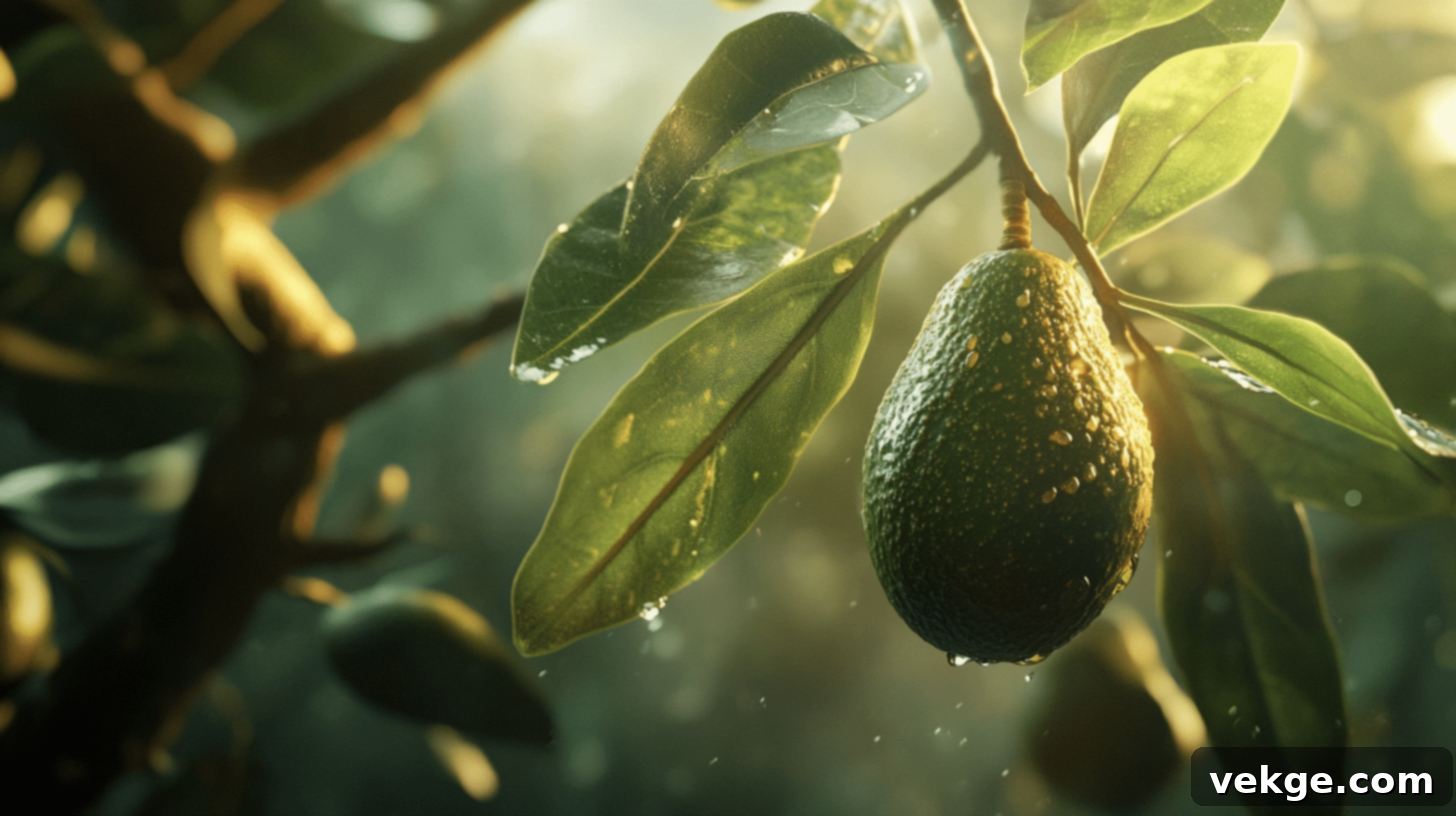Mastering Avocado Tree Growth: A Comprehensive Guide from Seed to Harvest
Growing your own avocado tree can seem like a challenging endeavor. Many aspiring gardeners face hurdles, from successfully sprouting the pit to nurturing a young tree into maturity. I understand these struggles firsthand, as I’ve navigated them myself. However, through trial and error, I’ve discovered effective strategies that simplify the entire process, making it an incredibly rewarding experience.
In this in-depth guide, I’ll share my proven tips and techniques for cultivating a healthy, fruit-bearing avocado tree. We’ll cover every stage of its life, starting from the humble seed, progressing through its growth, and addressing common issues you might encounter. By the end, you’ll possess the essential knowledge and confidence to embark on your own avocado-growing journey, ultimately enjoying the unparalleled satisfaction of fresh, homegrown avocados.
Prepare to transform that discarded avocado pit into a thriving plant that could one day provide you with delicious, creamy fruit. Let’s dig in and begin your exciting avocado-growing adventure!
The Fascinating History and Significance of Avocado Trees
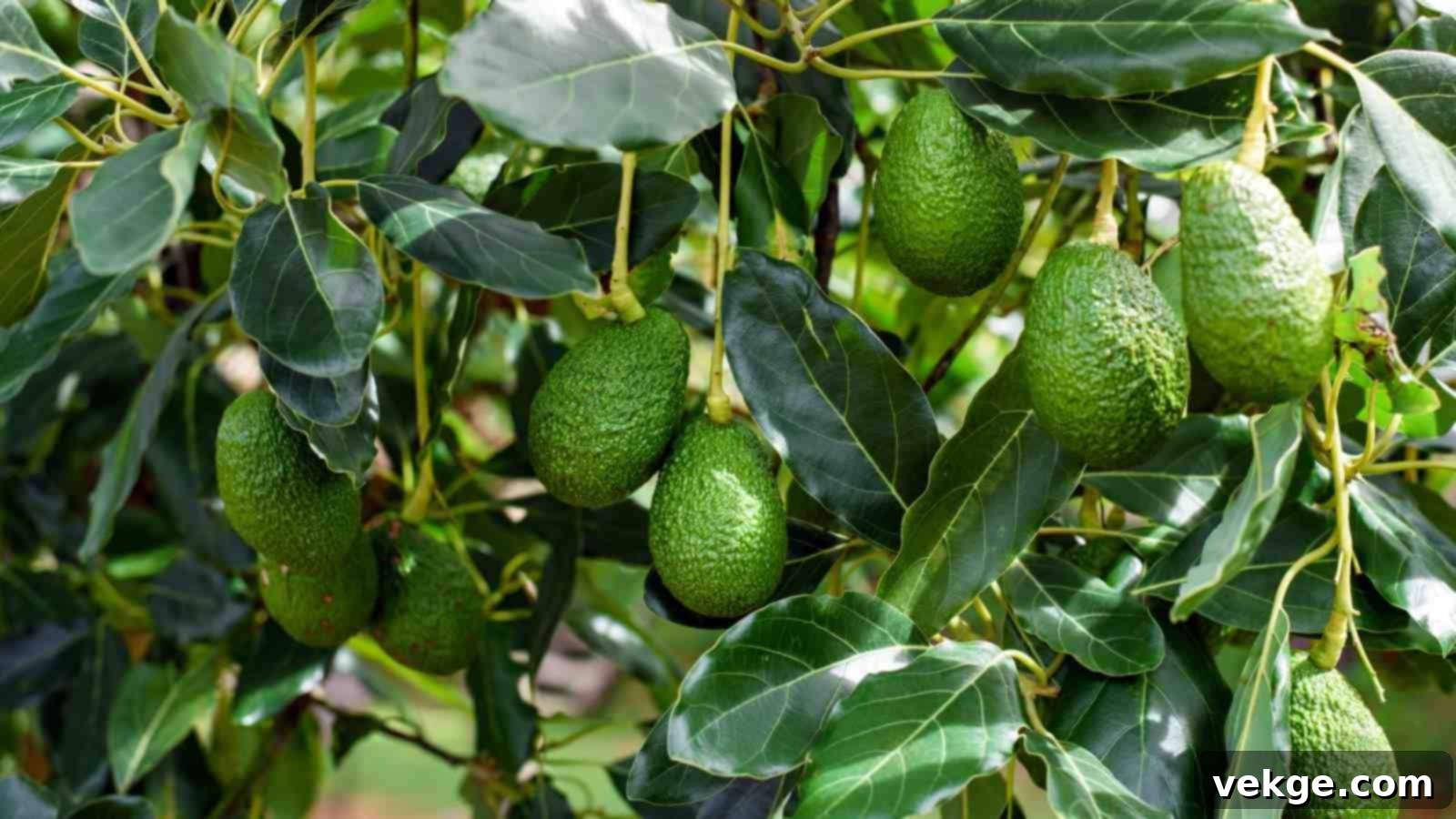
Avocado trees boast a rich and ancient history, stretching back thousands of years. Their journey from a staple food in ancient civilizations to a global culinary favorite is truly captivating and speaks to their enduring appeal.
Ancient Origins and Cultural Roots
These remarkable trees originated in south-central Mexico and Central America, where people have been cultivating and consuming avocados for approximately 10,000 years. Imagine a fruit with such deep roots in human history! The Aztecs, in particular, held avocados in high regard, referring to them as “ahuacatl.” This term, interestingly, also meant “testicle” in their Nahuatl language, likely due to the fruit’s shape and how it hangs on the tree – a detail that often sparks a chuckle today.
The arrival of Spanish explorers in the 1500s marked a significant turning point. They quickly recognized the value and deliciousness of avocados, introducing them to Europe and eventually other parts of the world. While initial adoption was slow in some regions, their popularity steadily grew.
The Rise of the Hass Avocado
Avocados truly began to gain widespread popularity in California during the early 20th century. A pivotal moment in this history came from a mailman named Rudolph Hass. In the 1920s, he discovered a unique avocado tree in his La Habra Heights backyard. This particular tree produced fruit with a superior flavor, richer texture, and a distinctive pebbly skin that turned black when ripe. This chance discovery led to the development of the ‘Hass’ avocado, which today accounts for the vast majority of avocados consumed worldwide. The Hass variety’s excellent taste, long shelf life, and ease of shipping cemented its place as the industry standard.
Modern Relevance and Nutritional Powerhouse
Beyond their historical journey, avocados have become incredibly significant in modern culture. They are a beloved ingredient in countless cuisines globally, from guacamole to salads, toasts, and even desserts. Their versatility is unmatched. Furthermore, avocados are celebrated for their impressive nutritional profile, packed with healthy monounsaturated fats, fiber, vitamins (C, E, K, B-6), and minerals (potassium, folate). This makes them a powerhouse food, contributing to heart health, digestion, and overall well-being. They are even utilized in medicinal applications and beauty products, underscoring their diverse benefits.
Today, avocado trees flourish in warm climates across the globe, from the sun-drenched groves of California to the fertile lands of Australia. By growing your own avocado tree, you’re not just cultivating a plant; you’re connecting with a vibrant piece of agricultural history and a living testament to nature’s bounty right in your own garden.
Popular Avocado Tree Varieties for Home Growers
While the Hass avocado dominates the commercial market, there’s a fascinating array of avocado varieties available, each with its unique characteristics, growth habits, and suitability for different climates. Knowing these types can help you choose the best tree for your garden. Prices listed are approximate for young trees and can vary based on size, supplier, and region.
| Avocado Variety | Key Characteristics | Price Range (Young Tree) |
|---|---|---|
| Hass Avocado | Most popular globally. Small to medium size, rich, creamy flesh, black pebbly skin when ripe. Type A flower. | $30 – $100 |
| Bacon Avocado | Medium size, smooth green skin, lighter flavor than Hass. Cold-hardy (down to 25°F). Type B flower. | $25 – $80 |
| Fuerte Avocado | Pear-shaped, smooth green skin, excellent flavor. Moderately cold-hardy. Type B flower. | $35 – $120 |
| Reed Avocado | Large, round fruit, green skin even when ripe. Buttery, nutty flavor. Type A flower. | $40 – $90 |
| Pinkerton Avocado | Pear-shaped, green pebbly skin, excellent flavor, small seed. Good yield. Type A flower. | $30 – $95 |
| Zutano Avocado | Medium to large, shiny green skin, lighter flavor. Very cold-hardy (down to 20°F). Type B flower. | $25 – $85 |
| Lamb Hass Avocado | Similar to Hass but larger fruit, later harvest. More vigorous tree. Type A flower. | $40 – $110 |
| Gwen Avocado | Similar to Hass in flavor and texture, but slightly larger and stays green when ripe. Dwarf-like growth. Type A flower. | $30 – $90 |
| Mexicola Avocado | Small fruit, thin edible skin, rich flavor. Very cold-hardy. Type A flower. | $25 – $75 |
| Wurtz (Dwarf) Avocado | True dwarf variety, ideal for containers or small spaces. Medium fruit with good flavor. Type A flower. | $40 – $100 |
When selecting a variety, consider your local climate, available space, and desired fruit characteristics. For better fruit production, especially in areas with fewer pollinators, planting a combination of Type A and Type B flowering trees is often recommended.
How to Propagate Your Own Avocado Tree
There are two primary methods for propagating an avocado tree: growing from seed, which is a delightful experiment, and grafting, a more advanced technique favored for faster fruit production and true-to-type varieties. Each method has its unique charm and benefits.
1. Propagating Avocado from Seed: The Classic Home Method
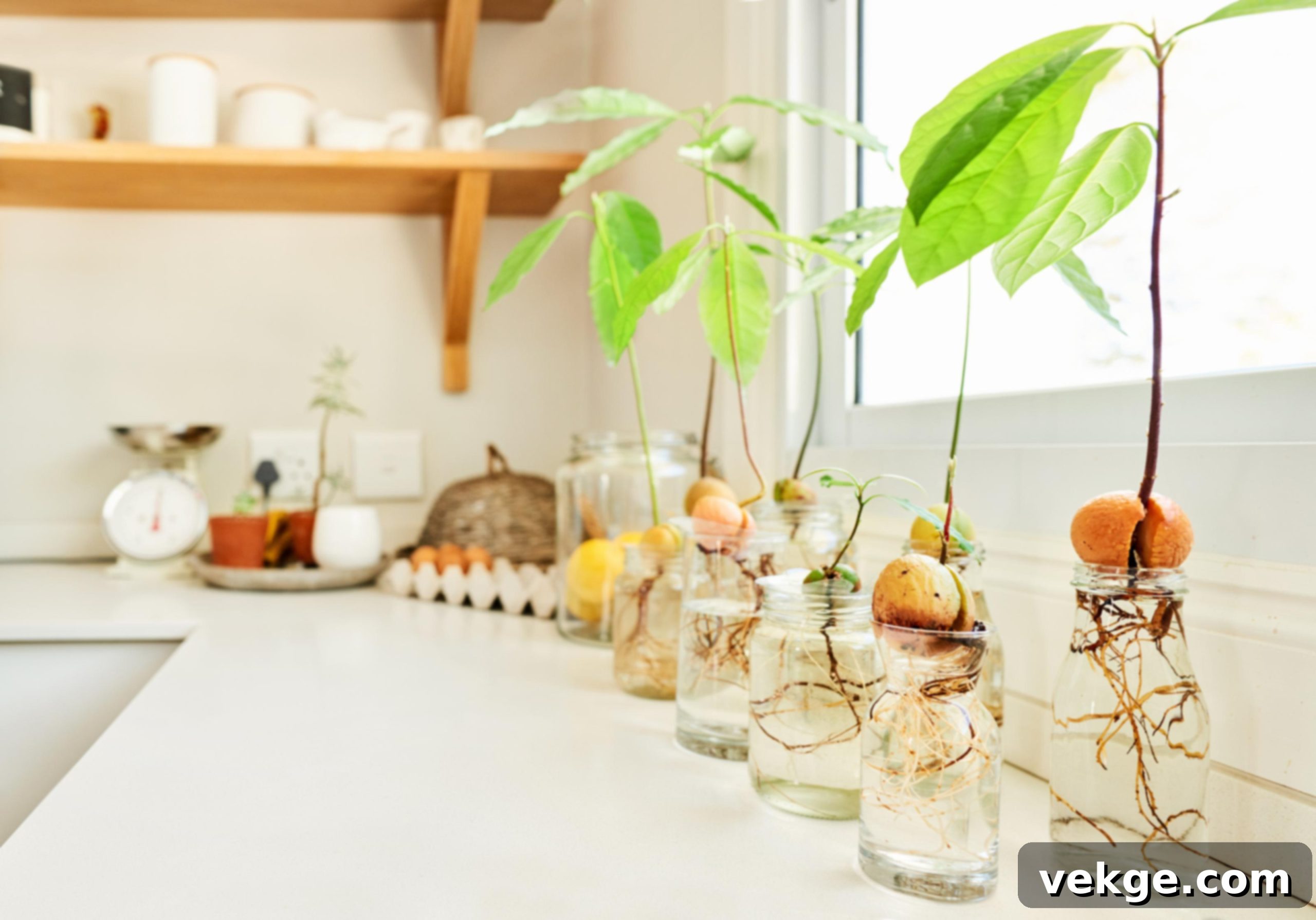
This is arguably the most common and enjoyable method, especially for beginners. While it can take many years for a seed-grown tree to produce fruit (and the fruit may not be identical to its parent), it’s a fantastic way to observe the miracle of life unfolding.
| Step | Action & Detail |
|---|---|
| 1. Remove and Clean the Pit | Carefully extract the pit from a ripe avocado. Gently wash off any remaining avocado flesh. Be cautious not to remove the brown seed coat, as this protects the embryo. Allow the pit to air dry for an hour or two. |
| 2. Prepare the Pit for Sprouting | Locate the slightly pointed top and the flatter bottom of the pit. Insert three to four toothpicks evenly around the middle of the pit, poking them in just deep enough to secure them. These toothpicks will act as a scaffold, allowing the pit to rest on the rim of a glass. |
| 3. Suspend in Water | Place the pit, pointed side up, over a glass filled with water. The flat bottom of the pit should be submerged in about an inch of water. Ensure it’s in a warm spot that receives indirect sunlight, like a windowsill. Change the water every few days to prevent mold and ensure oxygen availability. |
| 4. The Waiting Game: Rooting and Sprouting | Patience is key! After approximately 2-6 weeks (sometimes longer), the pit will typically split from the bottom, and a taproot will emerge and grow downwards into the water. Shortly after, a sprout will appear from the top of the pit. Continue changing the water regularly. |
| 5. Transplanting to Soil | Once the main sprout reaches about 6-8 inches tall, cut it back to approximately 3 inches. This encourages stronger root development and bushier growth. When the root system is well-established (several inches long with secondary roots), it’s time to plant. Choose a 8-10 inch pot with good drainage holes and fill it with a well-draining potting mix (a blend for citrus or cacti works well, or add perlite to regular potting soil). Plant the seedling so the top half of the avocado pit remains exposed above the soil line. |
| 6. Initial Care for Your Seedling | Place the potted seedling in a warm location that receives plenty of bright, indirect sunlight. Water thoroughly after planting and maintain consistent moisture in the soil, ensuring it’s damp but never waterlogged. Overwatering is a common killer of young avocado plants. |
2. Grafting an Avocado Tree: For Faster Fruit and Predictable Results
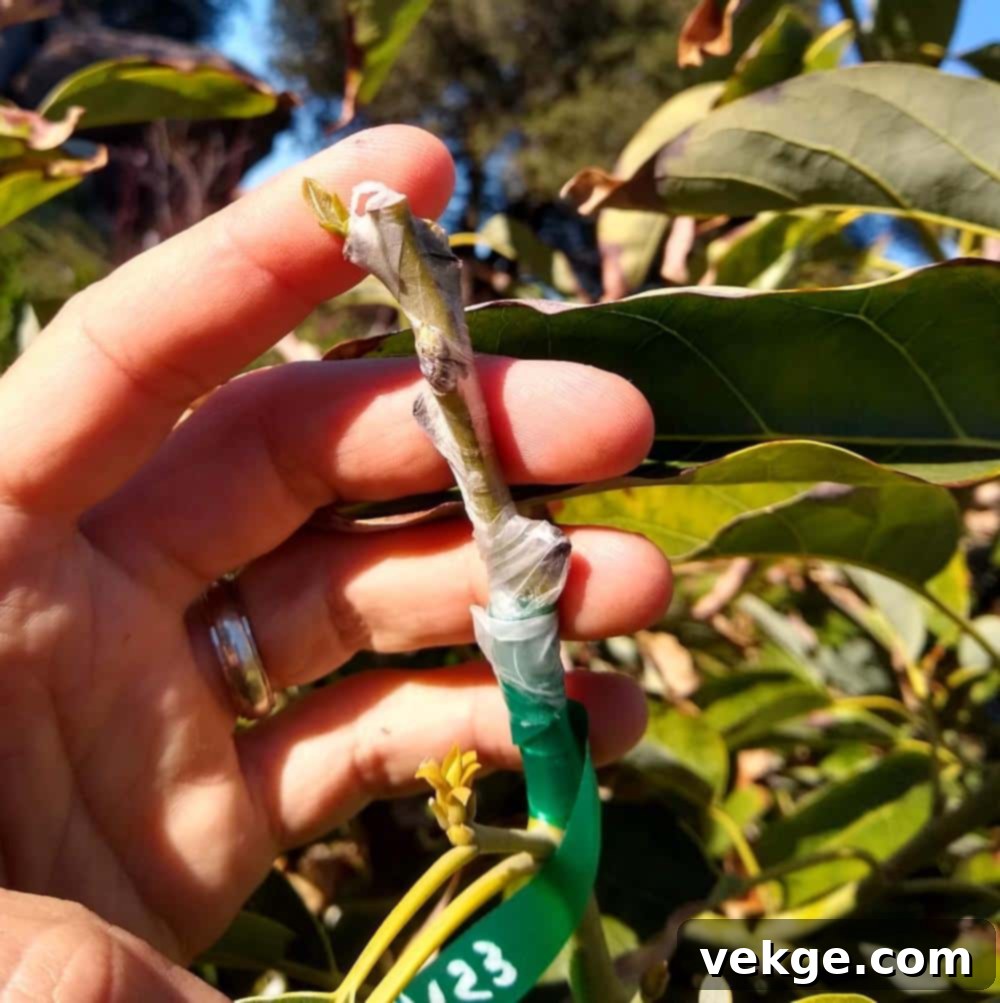
Grafting is a more advanced technique that involves joining a desirable ‘scion’ (a cutting from a mature, fruit-producing tree) onto a ‘rootstock’ (a young tree grown from seed). This method offers significant advantages: it ensures the new tree will produce fruit identical to the scion parent, and it dramatically reduces the time to fruiting, often yielding fruit within 3-4 years.
| Step | Action & Detail |
|---|---|
| 1. Choose Rootstock and Scion | Select a healthy, vigorous rootstock, typically a young avocado tree grown from seed (at least pencil-thick in diameter). For the scion, choose a dormant, pencil-thick branch from a mature avocado tree known for its high-quality fruit. The scion should have 3-4 healthy buds and be about 4-6 inches long. |
| 2. Prepare the Rootstock | Using a sharp, sterilized grafting knife, make a clean, slanted cut (about 1-2 inches long) on the top of the rootstock, ensuring the cut surface is smooth. You can also make a ‘V’ cut, or a cleft graft, depending on your preferred method. |
| 3. Prepare the Scion | Make a matching cut on the bottom end of your chosen scion. The goal is for the two cut surfaces (cambium layers) to align perfectly when joined. This precise fit is crucial for successful fusion. |
| 4. Join and Secure the Graft | Carefully align the cut surfaces of the scion and rootstock, making sure the cambium layers (the green layer just under the bark) are in contact on at least one side. Bind them tightly together using specialized grafting tape or rubber bands. This creates a secure union and prevents moisture loss. You can also cover the entire scion with grafting wax or parafilm to further protect it. |
| 5. Post-Graft Care | Place the grafted plant in a warm, protected environment, away from direct harsh sun and strong winds. Maintain regular watering, keeping the soil consistently moist but never waterlogged. High humidity can aid healing. After several weeks, if the graft is successful, you’ll observe new, healthy growth emerging from the scion. |
| 6. Remove Tape | Once the graft has visibly healed and the tree shows robust new growth (typically 2-3 months), carefully remove the grafting tape. Be gentle to avoid damaging the new union. Continue with regular avocado tree care. |
Whether you choose the rewarding experience of growing from seed or the more efficient method of grafting, successfully propagating an avocado tree is a fulfilling step towards enjoying your very own homegrown fruit.
How to Grow and Cultivate Avocado Trees in Your Garden
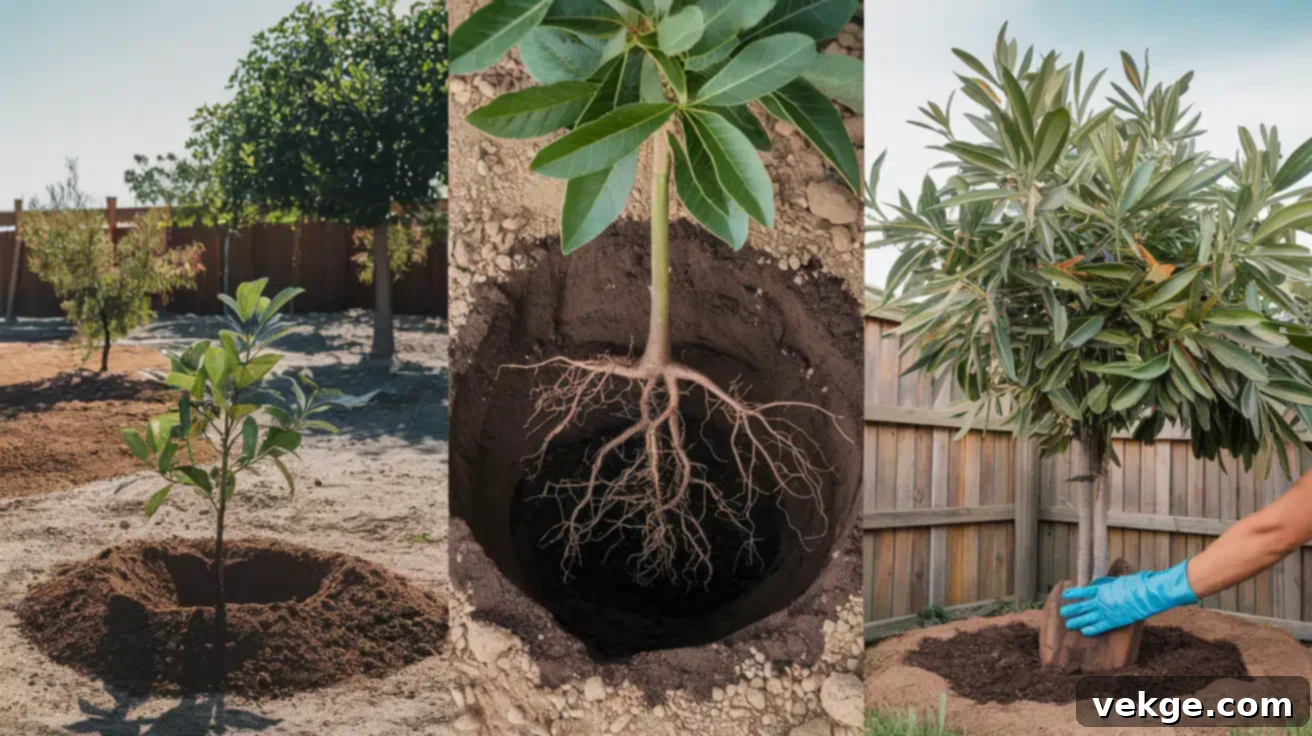
Cultivating avocado trees in your garden is an incredibly satisfying journey, transforming a small plant into a generous provider of delicious fruit. Based on my own experiences, here’s a comprehensive guide to help you establish and nurture a thriving avocado tree outdoors.
1. Selecting the Ideal Location
- Sunlight is Key: Avocado trees are sun-worshippers! Choose a spot in your garden that receives at least 6-8 hours of direct sunlight per day. Adequate light is crucial for photosynthesis, growth, and fruit production.
- Protection from Elements: While they love sun, young avocado trees are susceptible to strong winds and frost. Select a location sheltered from harsh winds, perhaps near a fence, building, or larger, established trees. In colder climates, consider planting on the south-facing side of a structure to maximize warmth and protection.
- Space Considerations: Remember that avocado trees can grow quite large (up to 30-40 feet tall and wide, though many can be pruned to a manageable size). Ensure there’s enough space for the tree to spread without crowding other plants or structures.
2. Preparing the Soil
- Excellent Drainage is Paramount: Avocados absolutely despise “wet feet.” They thrive in well-draining soil and are highly prone to root rot in waterlogged conditions. If your soil is heavy clay, you must amend it significantly.
- Soil Amendment: Improve drainage by incorporating plenty of organic matter like compost, aged manure, or bark chips. Mixing in coarse sand or perlite can also help. A raised bed can be an excellent solution for areas with naturally poor drainage.
- pH Preference: Avocado trees prefer slightly acidic to neutral soil, with a pH range of 6.0 to 7.0. A soil test can help you determine your current pH and guide any necessary adjustments.
3. Planting Your Avocado Tree
- Digging the Hole: Dig a planting hole that is twice as wide as the tree’s root ball and roughly the same depth. This wider hole allows the roots to spread easily into looser soil.
- Planting Depth: Carefully remove the tree from its nursery pot. Place it in the center of the hole, ensuring the top of the root ball is level with or slightly above the surrounding soil line. It’s better to plant a little high than too deep, as planting too deep can suffocate the roots.
- Backfill and Water: Gently backfill the hole with the amended soil, lightly tamping it down to remove large air pockets. Create a small soil berm around the edge of the planting hole to create a watering basin. Water thoroughly immediately after planting to settle the soil around the roots.
4. Watering Regimen
- Young Trees Need More: Young avocado trees have shallow root systems and require consistent moisture. I typically deep water mine once or twice a week, especially during warm, dry periods. The goal is to keep the soil consistently moist but never soggy.
- Mature Trees: As the tree matures, its root system becomes more extensive, allowing it to tap into deeper moisture. You can reduce the watering frequency, but deep watering is still essential.
- How to Check: Always check the soil moisture before watering. Stick your finger 2-3 inches into the soil; if it feels dry, it’s time to water. Yellowing leaves can often indicate overwatering, while wilting leaves might signal underwatering.
- Mulching: Apply a 3-4 inch layer of organic mulch (like wood chips or compost) around the base of the tree, keeping it a few inches away from the trunk. Mulch helps retain soil moisture, suppress weeds, and regulate soil temperature.
5. Fertilization
- Balanced Nutrition: Avocado trees are moderate feeders. Use a balanced fertilizer specifically formulated for citrus or avocado trees, or one with a slightly higher nitrogen content (e.g., 6-4-2 or 8-3-9).
- Timing: Fertilize young trees lightly every 1-2 months during their active growing season (spring through fall). For mature, fruit-bearing trees, fertilize in early spring, mid-summer, and early fall. Avoid fertilizing in winter when the tree is dormant.
- Micronutrients: Avocados can be prone to zinc and iron deficiencies. If you notice yellowing between leaf veins (chlorosis), consider a foliar spray or soil amendment containing these micronutrients.
6. Pruning and Shaping
- Formative Pruning: In the early years, prune to establish a strong central leader and a good branch structure. Remove any suckers growing from the base of the tree or branches growing at narrow angles.
- Maintenance Pruning: Once established, prune annually in late spring or early summer (after harvest, if applicable) to remove dead, diseased, or damaged branches. Thin out overcrowded areas to improve air circulation and light penetration, which helps with fruit production.
- Size Control: If you need to manage the tree’s size, you can carefully prune back taller branches to a strong side branch, encouraging a more compact growth habit.
7. The Reward of Patience
Growing an avocado tree from a young plant requires patience. While grafted trees can produce fruit in 3-4 years, seed-grown trees may take 5-13 years, or even longer, to bear fruit. However, the wait is truly worthwhile! The flavor, texture, and satisfaction of harvesting your own homegrown avocados are unparalleled.
Every garden and climate is unique, so observe your tree closely and adjust these tips as needed to fit your specific conditions. With consistent care and a little bit of dedication, you’ll be well on your way to enjoying a bountiful harvest from your very own avocado tree!
How Pollination Works in Avocado Trees: A Unique Biological Dance

The pollination process in avocado trees is fascinating and quite unique among fruit trees, involving a specialized mechanism called dichogamy. This adaptation helps prevent self-pollination and encourages genetic diversity, though it can sometimes be a challenge for home growers to understand.
Understanding Dichogamy: The Flower Phases
Avocado flowers possess both male and female reproductive organs, but they don’t function simultaneously. Instead, they open and close in distinct phases to ensure cross-pollination. This is known as “synchronous dichogamy.”
- Female Phase: The flower first opens in its female phase. During this time, the stigma (the receptive part for pollen) is ready to receive pollen, but the anthers (the male parts containing pollen) are not yet mature or receptive.
- Male Phase: After a few hours, the same flower closes. It then reopens later, typically on a different day, in its male phase. Now, the anthers release viable pollen, but the stigma is no longer receptive.
Two Main Flower Types: A and B
To further complicate (and optimize) this process, avocado varieties are categorized into two main types based on their specific flowering schedule:
- Type A Flowers: These flowers open in the morning in their female phase. They close around midday and then reopen the following afternoon in their male phase, releasing pollen. (e.g., Hass, Gwen, Pinkerton, Reed)
- Type B Flowers: These flowers open in the afternoon in their female phase. They close overnight and then reopen the following morning in their male phase, releasing pollen. (e.g., Bacon, Fuerte, Zutano, Ettinger)
The Importance of Cross-Pollination and Pollinators
While an individual avocado tree can theoretically self-pollinate (a Type A flower, for example, could have its pollen carried by an insect to another Type A flower that is currently in its female phase), cross-pollination between Type A and Type B trees significantly improves fruit set and yield. This is because when a Type A tree is in its female phase (morning), a Type B tree is often simultaneously in its male phase (morning), and vice-versa in the afternoon.
- Key Pollinators: Bees are the primary pollinators for avocado trees. Other insects like flies and hoverflies can also contribute. They play a crucial role in transferring pollen between flowers and between different types of trees.
- Maximizing Pollination: For optimal fruit production in a home garden, it is highly recommended to plant at least one Type A tree and one Type B tree in close proximity. This ensures that male and female flowers are open and receptive at overlapping times, greatly increasing the chances of successful cross-pollination.
- Environmental Factors: Weather conditions can greatly impact pollination. Warm, calm days are ideal for bee activity. Cold, windy, or rainy weather can reduce pollinator activity and hinder the successful transfer of pollen.
In essence, avocado trees engage in a sophisticated dance of timed flower openings. While individual trees have mechanisms for self-pollination, planting both Type A and Type B varieties together, along with encouraging a healthy population of pollinators like bees, is the most effective strategy for ensuring a bountiful harvest of delicious avocados.
How to Care & Maintain Your Avocado Tree for Optimal Health and Fruit
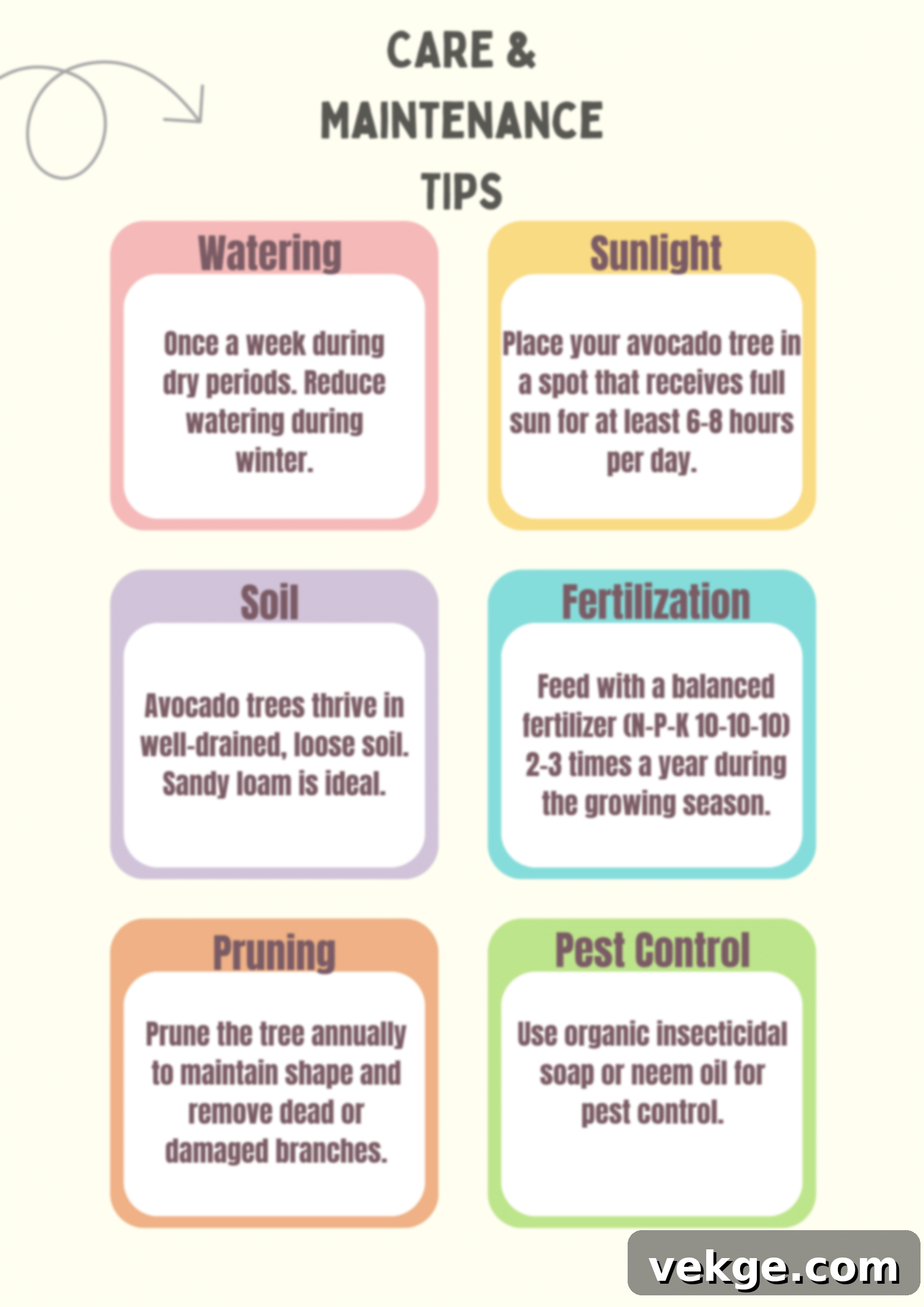
Beyond initial planting and propagation, consistent care and maintenance are vital to ensure your avocado tree thrives and produces fruit. Here’s a detailed breakdown of essential care practices:
1. Watering: The Foundation of Health
- Consistency is Key: Avocado trees need consistent moisture, especially young trees. Deep water 1-3 times a week, depending on your climate and soil type.
- Avoid Waterlogging: Ensure excellent drainage. Avocados are highly susceptible to root rot if their roots sit in standing water. Always check the top 2-3 inches of soil before watering again; it should feel dry to the touch.
- Deep Watering: When you water, do so slowly and deeply, allowing the water to penetrate the entire root zone. This encourages roots to grow deeper, making the tree more drought-tolerant.
- Monitoring: Observe your tree. Drooping leaves can indicate a need for water, while yellowing leaves are often a sign of overwatering.
2. Fertilization: Nourishing Your Tree
- Nutrient Needs: Avocado trees benefit from a balanced fertilizer. Look for formulas specifically designed for citrus or avocado trees, or a general slow-release fertilizer with a slightly higher nitrogen content (e.g., 6-4-2, 8-3-9).
- Application Schedule: For young trees (1-3 years), fertilize lightly every 1-2 months during the growing season (spring through fall). For mature, fruit-bearing trees, apply fertilizer three times a year: in early spring, mid-summer, and early fall.
- Micronutrients: Avocados are often prone to deficiencies in zinc, iron, and boron. If you notice signs like yellowing leaves with green veins (chlorosis) or stunted growth, consider a foliar spray or a soil drench rich in these micronutrients.
- Organic Options: Compost, worm castings, and fish emulsion are excellent organic choices to enrich the soil and provide a steady supply of nutrients.
3. Pruning: Shaping for Health and Productivity
- Deadwood and Disease: Regularly remove any dead, diseased, or damaged branches. This prevents the spread of disease and improves the tree’s overall health.
- Formative Pruning: In the first few years, prune to establish a strong structure. Remove suckers (shoots growing from the base or rootstock), and thin out branches that cross or rub against each other.
- Air Circulation and Light: Thinning the canopy improves air circulation, reducing the risk of fungal diseases, and allows more sunlight to reach the inner branches, promoting better fruit development.
- Size Management: You can prune to control the tree’s height and spread, making harvesting easier. Always prune back to a strong lateral branch or bud to encourage outward growth. The best time for major pruning is usually after fruit harvest, in late spring or early summer.
4. Pest and Disease Management: Staying Vigilant
- Common Pests: Watch out for pests like avocado thrips (which cause scarring on fruit), mites, scale insects, and mealybugs.
- Prevention: Encourage beneficial insects, maintain good air circulation, and inspect your tree regularly.
- Treatment: For minor infestations, horticultural oil or neem oil can be effective. For severe cases, consult local agricultural extension services for specific recommendations.
- Common Diseases: Root rot (Phytophthora cinnamomi) is the most common and destructive disease, caused by overwatering and poor drainage. Other issues include anthracnose (a fungal disease affecting fruit and leaves) and sunblotch (a viral disease causing distorted growth and fruit).
- Root Rot: Prevention is key – ensure excellent drainage! There are also resistant rootstocks available.
- Fungal Diseases: Good air circulation, proper pruning, and fungicide applications can help manage fungal issues.
- Sunblotch: No cure; prevent by using certified disease-free nursery stock.
5. Frost Protection: Guarding Against Cold
- Young Trees are Vulnerable: Avocado trees are generally tropical or subtropical and can be damaged by frost. Young trees are particularly susceptible.
- Protection Methods: In areas with occasional frost, cover young trees with blankets or burlap overnight. You can also string old-fashioned Christmas lights (incandescent, not LED) through the branches for warmth. For established trees, ensure they are well-watered before a frost event, as moist soil retains heat better.
- Variety Selection: If you live in a colder climate, choose more cold-hardy varieties like ‘Bacon,’ ‘Zutano,’ or ‘Mexicola.’
6. Growing in Containers (for Colder Climates or Limited Space)
- Dwarf Varieties: Dwarf varieties like ‘Wurtz’ (Little Cado) are excellent choices for container growing.
- Pot Size: Start with a 15-gallon pot and gradually move up to a 25-30 gallon pot as the tree grows. Ensure the pot has ample drainage holes.
- Soil and Water: Use a high-quality, well-draining potting mix. Container-grown trees often need more frequent watering and fertilization than those in the ground.
- Winter Care: Bring container trees indoors to a bright, sunny spot when temperatures drop below freezing.
By diligently following these care and maintenance guidelines, you’ll provide your avocado tree with the best possible environment to flourish, leading to a healthier tree and, eventually, a rewarding harvest of delicious fruit.
How Long Does It Take for An Avocado Tree to Bear Fruit?
One of the most common questions and sources of anticipation for any avocado enthusiast is, “When will my tree produce fruit?” The answer isn’t always straightforward, as the time to fruiting can vary significantly depending on several factors. My own experience has certainly taught me the value of patience in this endeavor.
Seed-Grown vs. Grafted Trees: A Big Difference
- From Seed: The Long Game: If you’re growing an avocado tree from a pit, prepare for a long wait. These trees typically take anywhere from 5 to 13 years, and sometimes even longer, to start producing fruit. It’s a true test of patience! Furthermore, a tree grown from seed may not produce fruit identical to its parent tree, or it might produce fruit of inferior quality, or even no fruit at all. This is because seed-grown trees are genetically unique hybrids.
- Grafted Trees: The Faster Track: This is why most commercial orchards and home growers prefer grafted trees. When you purchase a grafted tree from a nursery, it’s essentially a clone of a mature, fruit-producing tree. These trees are known to produce fruit true to their variety and can start bearing within 3 to 4 years of planting, sometimes even sooner if you buy a more mature specimen. This was the route I chose for my first successful fruit-bearing avocado tree, and it definitely shortens the wait considerably.
Other Factors Influencing Fruiting Time
- Avocado Variety: Some varieties are naturally more precocious (fruit earlier) than others. For example, certain dwarf varieties or those specifically bred for early production might fruit quicker under ideal conditions.
- Climate and Environment: Avocado trees thrive in warm, subtropical climates with plenty of sun. If your tree is in an optimal environment with consistent temperatures, adequate sunlight, and protection from extremes (like frost), it is more likely to fruit sooner. Stress from cold, heat, or insufficient light can delay fruiting.
- Tree Health and Care: A well-cared-for tree is a productive tree. Consistent watering, proper fertilization, appropriate pruning, and protection from pests and diseases all contribute to the tree’s overall vigor. A healthy, stress-free tree allocates more energy to flower and fruit production.
- Pollination: As discussed earlier, effective pollination (especially cross-pollination between Type A and Type B varieties) is critical for fruit set. If pollination is insufficient, the tree may flower but not produce fruit.
- Age and Maturity: Regardless of propagation method, a tree needs to reach a certain level of physiological maturity before it can support fruit production. This involves developing a robust root system and sufficient canopy size.
From Flower to Ripe Fruit: The Final Wait
Even after your tree begins to flower and set fruit, there’s still a waiting period for the avocados to mature on the tree. This can range from 6 to 8 months, and in some varieties, even up to 18 months, depending on the climate and specific type. Unlike many fruits, avocados don’t ripen on the tree; they only begin to soften and become edible after being picked. This unique characteristic allows commercial growers to store avocados on the tree for extended periods.
Ultimately, every avocado tree has its own timeline. Some might surprise you with early fruit, while others take their sweet time. The most important thing is to enjoy the journey of nurturing your tree, and the reward of that first homegrown avocado will be all the sweeter for the wait!
Top Brands Selling the Best Avocados You Can Try (Online)
While the goal is to grow your own, sometimes you just can’t wait, or perhaps you live in a region where growing avocados isn’t feasible. When I’m looking for high-quality avocados to enjoy immediately, I often turn to trusted online retailers. Here are a few top brands known for delivering excellent avocados straight to your door:
- Zava Ranch – If you appreciate the finest quality and a direct-from-farm experience, Zava Ranch is a fantastic choice. Their dedication to freshness and flavor is evident in every order. I highly recommend trying them if you love premium avocados as much as I do!
- Avocadoorganic.com – I admit, I was initially hesitant about ordering fresh produce like avocados online. However, Avocadoorganic.com completely exceeded my expectations. The avocados I received were incredibly fresh, perfectly ripe, and often even better than what I typically find in local stores. It’s definitely a must-try for organic avocado lovers!
- Henryavocado.com – Discovering Henryavocado.com was a game-changer for me. Their commitment to delivering pristine, ready-to-eat avocados is impressive. Every batch I’ve received has been perfect – a true delight for anyone who enjoys a perfectly ripe avocado without the guesswork.
These brands offer a convenient way to enjoy fresh avocados, bridging the gap while your homegrown tree matures or simply providing a reliable source of quality fruit.
Conclusion: Your Avocado Adventure Awaits!
Embarking on the journey of growing an avocado tree is an incredibly rewarding experience, connecting you directly to nature’s bounty. From nurturing a humble pit into a sprouting seedling to observing the intricate dance of pollination and finally, the anticipation of your first fruit, every step is filled with discovery and satisfaction.
A Quick Note on Seed-Grown Trees: While immensely fun and educational, remember that growing an avocado from a seed typically means a longer wait for fruit – often 7-15 years – and there’s no guarantee the fruit will be true to the parent tree, or even produce fruit at all. For reliable, faster fruiting of a specific variety, a grafted tree is usually the best choice.
Imagine the pride of plucking a ripe avocado from your very own tree. That smooth, often pebbly skin yields to your gentle touch, hinting at the creamy green goodness inside. You split it open, revealing the vibrant, perfect flesh – a testament to your care and dedication. This isn’t just any avocado; it’s one you’ve nurtured from a tiny seed or a young graft, right in your own backyard or on your patio. Your friends and family will undoubtedly be amazed when you proudly declare, “I grew this myself!”
With the comprehensive guidance provided in this article – covering everything from selecting the right variety and proper propagation techniques to advanced care, understanding pollination, and safeguarding your tree from pests and diseases – you are now equipped with the knowledge to succeed. While patience is certainly a virtue in avocado cultivation, the enduring satisfaction and delicious rewards make every effort worthwhile.
So, take the plunge! Let the green times roll, and prepare for an abundance of fresh, flavorful avocados. Your personal avocado adventure awaits!
